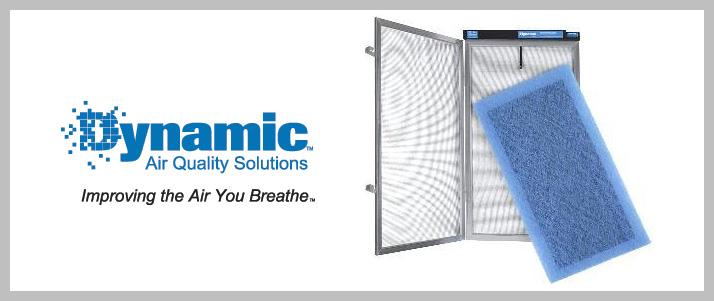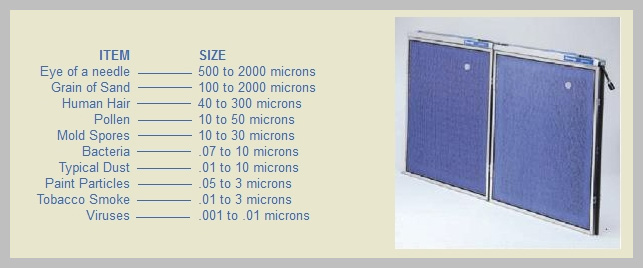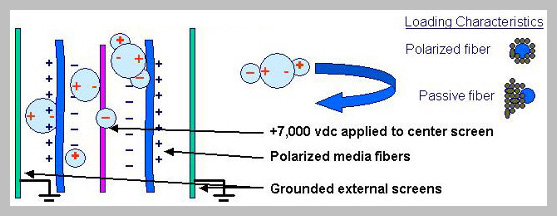Dynamic Filters
Having a Quality HVAC Filter Improves the Life of Your Myrtle Beach HVAC System
DYNAMIC PRODUCT LINE

Combining ease of installation with low static pressure (for lower energy consumption and system wear), 1" Dynamic Air Cleaners are high-efficiency whole-house electronic air cleaners with an equivalency rating of MERV 13. As tiny sub-micron particles and volatile organic compounds (VOCs) pass through the centra heating and cooling system, they become polarized. The polarized particles get larger as they join together with other polarized particles and collect on a disposable low-static polarized media pad with an activated charcoal center screen.
Air Cleaners remove difficult odors and provide an efficiency of 97% for particles down to .3 microns in size. 1" panels fit directly into existing filter racks or filter grilles and are powered using simple 24V wiring connected to the central HVAC system.
Combining ease of installation with low static pressure (for lower energy consumption and system wear), 1" Dynamic Air Cleaners are high-efficiency whole-house electronic air cleaners with an equivalency rating of MERV 13. As tiny sub-micron particles and volatile organic compounds (VOCs) pass through the central heating and cooling system, they become polarized. The polarized particles get larger as they join together with other polarized particles and collect on a disposable low-static polarized media pad with an activated charcoal center screen.
Dynamic Air Cleaners remove difficult odors and provide an efficiency of 97% for particles down to .3 microns in size. 1" panels fit directly into existing filter racks or filter grilles and are powered using simple 24V wiring connected to the central HVAC system.
What's MERV?
MERV, or Minimum Efficiency Reporting Value, is a number from 1 to 16 that is relative to air filter efficiency. The higher the MERV value, the more efficient the air filter is at removing particles. At the lower end of the efficiency spectrum a fiberglass panel filter may achieve MERV 4 or 5. At the higher end, filters that achieve MERV 13 or 14 are typically used in hospitals and clean rooms. High MERV filters are capable of removing higher quantities of extremely small contaminant (particles as small as 1/300 the diameter of a human hair). Higher MERV ratings can create problems with greater airflow resistance. This is also referred to as static pressure. With most filters the filter media becomes denser, and static pressure increase, as the filter efficiency increases. Increased static pressure forces the system fan motor to work harder as it pushes air through the filter. This also increases energy consumption. So for optimum performance, consumers should select the highest efficiency filter with the lowest static pressure.
What's a micron?
Particle size is usually measured in microns, a metric unit of measure. A micron is 1/25,000 of an inch. There are over 20 million particles in the average cubic foot of indoor air.
Approximately 98% of all particles (by count) are in the size range of 5 microns or less. Visible particles represent only a small fraction of particles found in indoor air.

2" Polarized-Media Electronic Air Cleaners
For commercial applications, 2" Dynamic Air Cleaners are available in individual panels or in multiple tandem units that wire to a single power supply or control panel (control panels are available as optional accessories). 2" Dynamic Air Cleaners slide directly into 2" filter tracks in most rooftop units or can be configured into V-Banks.
Operation Principles
Dynamic's patented technology uses an active electrostatic field to polarize both the fibers of a media pad and the particles to be removed. The polarized particles are drawn to the polarized media fibers and to each other.

Passive mechanisms
because there is a media, there is passive collection.
Polarization and electrostatic attraction
Polarized fibers collect polarized and charged particles charged center screen collects polarized and charged particles.
Agglomeration
Natural process (Brownian Motion) greatly accelerated by the field inside the air cleaner. Polarized particles attract each other and charged particles to form bigger clusters that are more easily captured.
